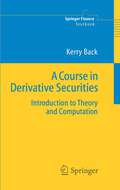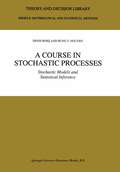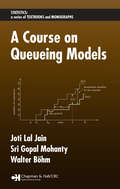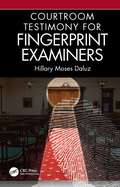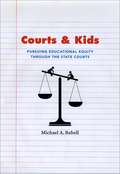- Table View
- List View
A Course in Derivative Securities: Introduction to Theory and Computation (Springer Finance)
by Kerry Back"Deals with pricing and hedging financial derivatives.… Computational methods are introduced and the text contains the Excel VBA routines corresponding to the formulas and procedures described in the book. This is valuable since computer simulation can help readers understand the theory….The book…succeeds in presenting intuitively advanced derivative modelling… it provides a useful bridge between introductory books and the more advanced literature." --MATHEMATICAL REVIEWS
A Course in In-Memory Data Management: The Inner Mechanics of In-Memory Databases
by Hasso PlattnerRecent achievements in hardware and software development, such as multi-core CPUs and DRAM capacities of multiple terabytes per server, enabled the introduction of a revolutionary technology: in-memory data management. This technology supports the flexible and extremely fast analysis of massive amounts of enterprise data. Professor Hasso Plattner and his research group at the Hasso Plattner Institute in Potsdam, Germany, have been investigating and teaching the corresponding concepts and their adoption in the software industry for years.This book is based on an online course that was first launched in autumn 2012 with more than 13,000 enrolled students and marked the successful starting point of the openHPI e-learning platform. The course is mainly designed for students of computer science, software engineering, and IT related subjects, but addresses business experts, software developers, technology experts, and IT analysts alike. Plattner and his group focus on exploring the inner mechanics of a column-oriented dictionary-encoded in-memory database. Covered topics include - amongst others - physical data storage and access, basic database operators, compression mechanisms, and parallel join algorithms. Beyond that, implications for future enterprise applications and their development are discussed. Step by step, readers will understand the radical differences and advantages of the new technology over traditional row-oriented, disk-based databases.In this completely revised 2nd edition, we incorporate the feedback of thousands of course participants on openHPI and take into account latest advancements in hard- and software. Improved figures, explanations, and examples further ease the understanding of the concepts presented. We introduce advanced data management techniques such as transparent aggregate caches and provide new showcases that demonstrate the potential of in-memory databases for two diverse industries: retail and life sciences.
A Course in In-Memory Data Management: The Inner Mechanics of In-Memory Databases
by Hasso PlattnerRecent achievements in hardware and software development, such as multi-core CPUs and DRAM capacities of multiple terabytes per server, enabled the introduction of a revolutionary technology: in-memory data management. This technology supports the flexible and extremely fast analysis of massive amounts of enterprise data. Professor Hasso Plattner and his research group at the Hasso Plattner Institute in Potsdam, Germany, have been investigating and teaching the corresponding concepts and their adoption in the software industry for years.This book is based on the first online course on the openHPI e-learning platform, which was launched in autumn 2012 with more than 13,000 learners. The book is designed for students of computer science, software engineering, and IT related subjects. However, it addresses business experts, decision makers, software developers, technology experts, and IT analysts alike. Plattner and his group focus on exploring the inner mechanics of a column-oriented dictionary-encoded in-memory database. Covered topics include - amongst others - physical data storage and access, basic database operators, compression mechanisms, and parallel join algorithms. Beyond that, implications for future enterprise applications and their development are discussed. Readers are lead to understand the radical differences and advantages of the new technology over traditional row-oriented disk-based databases.
A Course in Mathematical Statistics and Large Sample Theory (Springer Texts in Statistics)
by Rabi Bhattacharya Lizhen Lin Victor PatrangenaruThis graduate-level textbook is primarily aimed at graduate students of statistics, mathematics, science, and engineering who have had an undergraduate course in statistics, an upper division course in analysis, and some acquaintance with measure theoretic probability. It provides a rigorous presentation of the core of mathematical statistics.Part I of this book constitutes a one-semester course on basic parametric mathematical statistics. Part II deals with the large sample theory of statistics - parametric and nonparametric, and its contents may be covered in one semester as well. Part III provides brief accounts of a number of topics of current interest for practitioners and other disciplines whose work involves statistical methods.
A Course in Microeconomic Theory
by David M. KrepsDavid M. Kreps has developed a text in microeconomics that is both challenging and "user-friendly." The work is designed for the first-year graduate microeconomic theory course and is accessible to advanced undergraduates as well. Placing unusual emphasis on modern noncooperative game theory, it provides the student and instructor with a unified treatment of modern microeconomic theory--one that stresses the behavior of the individual actor (consumer or firm) in various institutional settings. The author has taken special pains to explore the fundamental assumptions of the theories and techniques studied, pointing out both strengths and weaknesses.The book begins with an exposition of the standard models of choice and the market, with extra attention paid to choice under uncertainty and dynamic choice. General and partial equilibrium approaches are blended, so that the student sees these approaches as points along a continuum. The work then turns to more modern developments. Readers are introduced to noncooperative game theory and shown how to model games and determine solution concepts. Models with incomplete information, the folk theorem and reputation, and bilateral bargaining are covered in depth. Information economics is explored next. A closing discussion concerns firms as organizations and gives readers a taste of transaction-cost economics.
A Course in Monetary Economics: Sequential Trade, Money, and Uncertainty
by Benjamin EdenA Course in Monetary Economics is an insightful introduction to advanced topics in monetary economics. Accessible to students who have mastered the diagrammatic tools of economics, it discusses real issues with a variety of modeling alternatives, allowing for a direct comparison of the implications of the different models. The exposition is clear and logical, providing a solid foundation in monetary theory and the techniques of economic modeling. The inventive analysis explores an extensive range of topics including the optimum quantity of money, optimal monetary and fiscal policy, and uncertain and sequential trade models. Additionally, the text contains a simple general equilibrium version of Lucas (1972) confusion hypothesis, and presents and synthesizes the results of recent empirical work. The text is rooted in the author's years of teaching and research, and will be highly suitable for monetary economics courses at both the upper-level undergraduate and graduate levels.
A Course in Stochastic Processes: Stochastic Models and Statistical Inference (Theory and Decision Library B #34)
by Denis Bosq Hung T. NguyenThis text is an Elementary Introduction to Stochastic Processes in discrete and continuous time with an initiation of the statistical inference. The material is standard and classical for a first course in Stochastic Processes at the senior/graduate level (lessons 1-12). To provide students with a view of statistics of stochastic processes, three lessons (13-15) were added. These lessons can be either optional or serve as an introduction to statistical inference with dependent observations. Several points of this text need to be elaborated, (1) The pedagogy is somewhat obvious. Since this text is designed for a one semester course, each lesson can be covered in one week or so. Having in mind a mixed audience of students from different departments (Math ematics, Statistics, Economics, Engineering, etc.) we have presented the material in each lesson in the most simple way, with emphasis on moti vation of concepts, aspects of applications and computational procedures. Basically, we try to explain to beginners questions such as "What is the topic in this lesson?" "Why this topic?", "How to study this topic math ematically?". The exercises at the end of each lesson will deepen the stu dents' understanding of the material, and test their ability to carry out basic computations. Exercises with an asterisk are optional (difficult) and might not be suitable for homework, but should provide food for thought.
A Course in Triangulations for Solving Equations with Deformations (Lecture Notes in Economics and Mathematical Systems #234)
by B. C. EavesA Course on Queueing Models (Statistics: Textbooks and Monographs)
by Joti Lal JainThe application of engineering principles in divergent fields such as management science and communications as well as the advancement of several approaches in theory and computation have led to growing interest in queueing models, creating the need for a comprehensive text. Emphasizing Markovian structures and the techniques that occur in differen
A Course on Small Area Estimation and Mixed Models: Methods, Theory and Applications in R (Statistics for Social and Behavioral Sciences)
by Domingo Morales María Dolores Esteban Agustín Pérez Tomáš HobzaThis advanced textbook explores small area estimation techniques, covers the underlying mathematical and statistical theory and offers hands-on support with their implementation. It presents the theory in a rigorous way and compares and contrasts various statistical methodologies, helping readers understand how to develop new methodologies for small area estimation. It also includes numerous sample applications of small area estimation techniques. The underlying R code is provided in the text and applied to four datasets that mimic data from labor markets and living conditions surveys, where the socioeconomic indicators include the small area estimation of total unemployment, unemployment rates, average annual household incomes and poverty indicators. Given its scope, the book will be useful for master and PhD students, and for official and other applied statisticians.
A Course on Statistics for Finance
by Stanley L. ScloveTaking a data-driven approach, A Course on Statistics for Finance presents statistical methods for financial investment analysis. The author introduces regression analysis, time series analysis, and multivariate analysis step by step using models and methods from finance. The book begins with a review of basic statistics, including descriptive statistics, kinds of variables, and types of data sets. It then discusses regression analysis in general terms and in terms of financial investment models, such as the capital asset pricing model and the Fama/French model. It also describes mean-variance portfolio analysis and concludes with a focus on time series analysis. Providing the connection between elementary statistics courses and quantitative finance courses, this text helps both existing and future quants improve their data analysis skills and better understand the modeling process.
A Course on Statistics for Finance
by Stanley L. ScloveTaking a data-driven approach, A Course on Statistics for Finance presents statistical methods for financial investment analysis. The author introduces regression analysis, time series analysis, and multivariate analysis step by step using models and methods from finance. The book begins with a review of basic statistics, including descriptive statistics, kinds of variables, and types of data sets. It then discusses regression analysis in general terms and in terms of financial investment models, such as the capital asset pricing model and the Fama/French model. It also describes mean-variance portfolio analysis and concludes with a focus on time series analysis. Providing the connection between elementary statistics courses and quantitative finance courses, this text helps both existing and future quants improve their data analysis skills and better understand the modeling process.
Coursebook for Economics: Private and Public Choice
by Richard Stroup A. H. Studenmund James D GwartneyCoursebook for Economics: Private and Public Choice contains questions and problems dealing with market decisions, market process, taxes, government spending. The book is designed to help students using the textbook "Economics: Private and Public Choice, Second Edition." The text also provides a section on "Problems and Projects" which emphasizes mechanics and economic reasoning with case-study type problems, report preparation, or economic data presentation for hypothesis development. The book also provides "complex application"-type problems which can be solved by the student's utilization of economic principles to realistic situations. The text showcases selected articles in the section "Perspectives in Economics" to expand on important concepts, to explain historical viewpoints, as well as to offer original ideas of current influential economists. Among the articles are: "How Government Profits from Inflation;" "The Awful Year Inflation Ran Wild;" "How the Federal Reserve Decides How Much Money to Put into the Economy;" and "The Roller-Coaster Income Tax." The book is suitable for students of economics and business, sociologists, general readers interested in real-world economics, and policy makers involved in national economic development.
Court Delay and Law Enforcement in China: Civil process and economic perspective (Ökonomische Analyse des Rechts)
by Qing-Yun JiangQing-Yun Jiang shows that court delay is not a serious problem in the lower courts in respect to trial cases, but mainly in appeal cases and retrial cases, which require more time. The author confirms that law enforcement has been an obstacle for the development of market economy and a bottleneck of the judiciary and he concludes that judicial reform should not only deal with symptoms, but with the roots of the political and economic structure.
The Court of Justice of the European Coal and Steel Community
by D.G. ValentineTHE CREATION OF THE COURT OF JUSTICE OF THE EUROPEAN COAL AND STEEL COMMUNITY On 9th May, 1950, M. Robert Schuman, the then Foreign Minister of France, speaking at a Press Conference in Paris, outlined the idea of establishing a Community within Europe to control the production of coal and steel. "The French Govern ment", he stated, "propose to place the whole of the Franco German production of coal and steel under a common high authorityl within an organisation open to the participation of other countries of Europe ... This will form the first concrete step towards a European Federation, which is indispensable for peace" 2. This statement, apart from the specific mention of a high authority, does not mention any proposed organs of such a Community, and, as will appear, no firm idea of the Community's structure existed at all at that date. Six weeks after this announcement in Paris, a Conference composed of the six States that were to form the Coal and Steel 4 Community3 met under the presidency of M. Monnet • This Conference continued its work "consciencieux et discret, rue 5 Martignac" until March, 1951 • The first reference that one finds to a judicial organ to control the activity of the Community is contained in the document sub mitted by the Commissariat general au Plan 6. When compared with 1 The term is given in small letters as a description rather than as a title. 2 Bulletin Quotidien, llth May, 1950.
Court-Supervised Restructuring of Large Distressed Companies in Asia: Law and Policy (Contemporary Studies in Corporate Law)
by Wai Yee WanThis book provides an in-depth analysis of 4 economically significant Asian jurisdictions: Mainland China, India, Hong Kong and Singapore. These jurisdictions have recently either reformed – or are considering reforming – their corporate restructuring laws to promote regimes conducive to restructuring financially distressed, but otherwise economically viable, companies. Mainland China, India, Hong Kong and Singapore continue to adhere to a framework that requires the court's final approval but draw references from Chapter 11 of the Bankruptcy Code 1978 in the United States and/or the schemes of arrangement in the United Kingdom. However, the institutional and market structures are very different in Asia; in particular, Asia has a far higher concentration in shareholdings among listed firms, including holdings by families and the state, and a different composition of creditors. The book explains how, notwithstanding the legal transplantation, corporate restructuring laws in these Asian jurisdictions have adapted and evolved due to the frictions in shareholder-creditor and creditor-creditor relationships, and the role of the state in resolving non-performing loans and financial distress of state-owned enterprises which are listed, or which issue public debt. The study argues that any reforms must go beyond professionalising the insolvency professionals and the judiciary but must be designed to address fundamental issues of corporate governance, bank regulation and enforcing non-bankruptcy rules. It offers invaluable insights for academics and policy makers alike.
Court-Supervised Restructuring of Large Distressed Companies in Asia: Law and Policy (Contemporary Studies in Corporate Law)
by Wai Yee WanThis book provides an in-depth analysis of 4 economically significant Asian jurisdictions: Mainland China, India, Hong Kong and Singapore. These jurisdictions have recently either reformed – or are considering reforming – their corporate restructuring laws to promote regimes conducive to restructuring financially distressed, but otherwise economically viable, companies. Mainland China, India, Hong Kong and Singapore continue to adhere to a framework that requires the court's final approval but draw references from Chapter 11 of the Bankruptcy Code 1978 in the United States and/or the schemes of arrangement in the United Kingdom. However, the institutional and market structures are very different in Asia; in particular, Asia has a far higher concentration in shareholdings among listed firms, including holdings by families and the state, and a different composition of creditors. The book explains how, notwithstanding the legal transplantation, corporate restructuring laws in these Asian jurisdictions have adapted and evolved due to the frictions in shareholder-creditor and creditor-creditor relationships, and the role of the state in resolving non-performing loans and financial distress of state-owned enterprises which are listed, or which issue public debt. The study argues that any reforms must go beyond professionalising the insolvency professionals and the judiciary but must be designed to address fundamental issues of corporate governance, bank regulation and enforcing non-bankruptcy rules. It offers invaluable insights for academics and policy makers alike.
Courteous Capitalism: Public Relations And The Monopoly Problem, 1900-1930 (Hagley Library Studies In Business, Technology, And Politics Ser.)
by Daniel RobertCourthouse Architecture, Design and Social Justice
by Emma Henderson Kirsty DuncansonThis collection interrogates relationships between court architecture and social justice, from consultation and design to the impact of material (and immaterial) forms on court users, through the lenses of architecture, law, socio-legal studies, criminology, anthropology, and a former high court judge. International multidisciplinary collaborations and single-author contributions traverse a range of methodological approaches to present new insights into the relationship between architecture, design, and justice. These include praxis, photography, reflections on process and decolonising practice, postcolonial, feminist, and poststructural analysis, and theory from critical legal scholarship, political science, criminology, literature, sociology, and architecture. While the opening contributions reflect on establishing design principles and architectural methodologies for ethical consultation and collaboration with communities historically marginalised and exploited by law, the central chapters explore the textures and affects of built forms and the spaces between; examining the disjuncture between design intention and use; and investigating the impact of architecture and the design of space. The collection finishes with contemplations of the very real significance of material presence or absence in courtroom spaces and what this might mean for justice. Courthouse Architecture, Design and Social Justice provides tools for those engaged in creating, and reflecting on, ethical design and building use, and deepens the dialogue across disciplinary boundaries towards further collaborative work in the field. It also exists as a new resource for research and teaching, facilitating undergraduate critical thought about the ways in which design enhances and restricts access to justice.
Courthouse Architecture, Design and Social Justice
by Emma Henderson Kirsty DuncansonThis collection interrogates relationships between court architecture and social justice, from consultation and design to the impact of material (and immaterial) forms on court users, through the lenses of architecture, law, socio-legal studies, criminology, anthropology, and a former high court judge. International multidisciplinary collaborations and single-author contributions traverse a range of methodological approaches to present new insights into the relationship between architecture, design, and justice. These include praxis, photography, reflections on process and decolonising practice, postcolonial, feminist, and poststructural analysis, and theory from critical legal scholarship, political science, criminology, literature, sociology, and architecture. While the opening contributions reflect on establishing design principles and architectural methodologies for ethical consultation and collaboration with communities historically marginalised and exploited by law, the central chapters explore the textures and affects of built forms and the spaces between; examining the disjuncture between design intention and use; and investigating the impact of architecture and the design of space. The collection finishes with contemplations of the very real significance of material presence or absence in courtroom spaces and what this might mean for justice. Courthouse Architecture, Design and Social Justice provides tools for those engaged in creating, and reflecting on, ethical design and building use, and deepens the dialogue across disciplinary boundaries towards further collaborative work in the field. It also exists as a new resource for research and teaching, facilitating undergraduate critical thought about the ways in which design enhances and restricts access to justice.
Courting Failure: How Competition for Big Cases Is Corrupting the Bankruptcy Courts
by Lynn M. LoPuckiLoPucki's provocative critique of Chapter 11 is required reading for everyone who cares about bankruptcy reform. This empirical account of large Chapter 11 cases will trigger intense debate both inside the academy and on the floor of Congress. Confronting LoPucki's controversial thesis-that competition between bankruptcy judges is corrupting them-is the most pressing challenge now facing any defender of the status quo." -Douglas Baird, University of Chicago Law School "This book is smart, shocking and funny. This story has everything-professional greed, wrecked companies, and embarrassed judges. Insiders are already buzzing." -Elizabeth Warren, Leo Gottlieb Professor of Law, Harvard Law School "LoPucki provides a scathing attack on reorganization practice. Courting Failure recounts how lawyers, managers and judges have transformed Chapter 11. It uses empirical data to explore how the interests of the various participants have combined to create a system markedly different from the one envisioned by Congress. LoPucki not only questions the wisdom of these changes but also the free market ideology that supports much of the general regulation of the corporate sector." -Robert Rasmussen, University of Chicago Law School A sobering chronicle of our broken bankruptcy-court system, Courting Failure exposes yet another American institution corrupted by greed, avarice, and the thirst for power. Lynn LoPucki's eye-opening account of the widespread and systematic decay of America's bankruptcy courts is a blockbuster story that has yet to be reported in the media. LoPucki reveals the profound corruption in the U.S. bankruptcy system and how this breakdown has directly led to the major corporate failures of the last decade, including Enron, MCI, WorldCom, and Global Crossing. LoPucki, one of the nation's leading experts on bankruptcy law, offers a clear and compelling picture of the destructive power of "forum shopping," in which corporations choose courts that offer the most favorable outcome for bankruptcy litigation. The courts, lured by big money and prestige, streamline their requirements and lower their standards to compete for these lucrative cases. The result has been a series of increasingly shoddy reorganizations of major American corporations, proposed by greedy corporate executives and authorized by case-hungry judges.
Courtroom Testimony for Fingerprint Examiners
by Hillary Moses DaluzFingerprint examiners today are expected to develop, research and defend the scientific basis of their conclusions. Recent emphasis placed on scientific rigor and transparency through documentation has created a culture shift in the field. Many examiners are baffled by the resulting cultural, procedural and scientific distinctions, often becoming overwhelmed when required to testify as an expert witness to explain such concepts in the courtroom. Courtroom Testimony for Fingerprint Examiners addresses all aspects of courtroom testimony as the first book to focus solely on testifying on fingerprint evidence as a comparative science. The book is presented in two parts. Section I addresses general expert witnessing for forensic scientists. This serves as a primer for the novice or a review for experienced witnesses covering such topics as the structure of the criminal justice system and federal rules of evidence, the role of the expert witness, testimony as teaching, presenting challenging scientific concepts to the layperson, court preparation, the three phases of expert witness testimony and landmark court decisions that have shaped the modern landscape of forensic testimony. Section II focuses on specific issues affecting fingerprint examiners and how to field questions during both direct and cross-examination. While such "hot button" topics are absent from currently available texts, this section pays particular attention to these salient, emerging topics. This includes evidentiary challenges to fingerprint evidence, relevant publications such as the PCAST report, nomenclature and standards development, issues surrounding cognitive bias and subjectivity, probability models, error rates and cases of error and how to address issues of minimum point standards in both the empirical and holistic traditions. Both Section I and Section II provide examples and present innovations applicable to latent and tenprint examiners. Features include: Presents a history of fingerprint evidence and current best practices and limits on characterizing fingerprint evidence in court, including appropriate nomenclature Provides current guidelines and recommendations for standards and the courtroom Illustrates how experts can work with attorneys so that the testimony process educates and informs jurors and judges rather than perpetuating an adversarial dynamic Addresses important issues such as cognitive bias, subjectivity, error rates, probability models and ethics As a forensic training instructor for professionals – and previously as a college professor – author Hillary Moses Daluz has spent the past ten years teaching courtroom testimony courses to forensic scientists. Courtroom Testimony for Fingerprint Examiners offers an invaluable resource to forensic scientists, latent print examiners, tenprint examiners, lab personnel in related comparative fields, attorneys, investigative professionals and students enrolled in forensic science university programs.
Courtroom Testimony for Fingerprint Examiners
by Hillary Moses DaluzFingerprint examiners today are expected to develop, research and defend the scientific basis of their conclusions. Recent emphasis placed on scientific rigor and transparency through documentation has created a culture shift in the field. Many examiners are baffled by the resulting cultural, procedural and scientific distinctions, often becoming overwhelmed when required to testify as an expert witness to explain such concepts in the courtroom. Courtroom Testimony for Fingerprint Examiners addresses all aspects of courtroom testimony as the first book to focus solely on testifying on fingerprint evidence as a comparative science. The book is presented in two parts. Section I addresses general expert witnessing for forensic scientists. This serves as a primer for the novice or a review for experienced witnesses covering such topics as the structure of the criminal justice system and federal rules of evidence, the role of the expert witness, testimony as teaching, presenting challenging scientific concepts to the layperson, court preparation, the three phases of expert witness testimony and landmark court decisions that have shaped the modern landscape of forensic testimony. Section II focuses on specific issues affecting fingerprint examiners and how to field questions during both direct and cross-examination. While such "hot button" topics are absent from currently available texts, this section pays particular attention to these salient, emerging topics. This includes evidentiary challenges to fingerprint evidence, relevant publications such as the PCAST report, nomenclature and standards development, issues surrounding cognitive bias and subjectivity, probability models, error rates and cases of error and how to address issues of minimum point standards in both the empirical and holistic traditions. Both Section I and Section II provide examples and present innovations applicable to latent and tenprint examiners. Features include: Presents a history of fingerprint evidence and current best practices and limits on characterizing fingerprint evidence in court, including appropriate nomenclature Provides current guidelines and recommendations for standards and the courtroom Illustrates how experts can work with attorneys so that the testimony process educates and informs jurors and judges rather than perpetuating an adversarial dynamic Addresses important issues such as cognitive bias, subjectivity, error rates, probability models and ethics As a forensic training instructor for professionals – and previously as a college professor – author Hillary Moses Daluz has spent the past ten years teaching courtroom testimony courses to forensic scientists. Courtroom Testimony for Fingerprint Examiners offers an invaluable resource to forensic scientists, latent print examiners, tenprint examiners, lab personnel in related comparative fields, attorneys, investigative professionals and students enrolled in forensic science university programs.
Courts and Kids: Pursuing Educational Equity through the State Courts
by Michael A. RebellOver the past thirty-five years, federal courts have dramatically retreated from actively promoting school desegregation. In the meantime, state courts have taken up the mantle of promoting the vision of educational equity originally articulated in Brown v. Board of Education. Courts and Kids is the first detailed analysis of why the state courts have taken on this active role and how successful their efforts have been. Since 1973, litigants have challenged the constitutionality of education finance systems in forty-five states on the grounds that they deprive many poor and minority students of adequate access to a sound education. While the plaintiffs have won in the majority of these cases, the decisions are often branded “judicial activism”—a stigma that has reduced their impact. To counter the charge, Michael A. Rebell persuasively defends the courts’ authority and responsibility to pursue the goal of educational equity. He envisions their ideal role as supervisory, and in Courts and Kids he offers innovative recommendations on how the courts can collaborate with the executive and legislative branches to create a truly democratic educational system.
Courts and Kids: Pursuing Educational Equity through the State Courts
by Michael A. RebellOver the past thirty-five years, federal courts have dramatically retreated from actively promoting school desegregation. In the meantime, state courts have taken up the mantle of promoting the vision of educational equity originally articulated in Brown v. Board of Education. Courts and Kids is the first detailed analysis of why the state courts have taken on this active role and how successful their efforts have been. Since 1973, litigants have challenged the constitutionality of education finance systems in forty-five states on the grounds that they deprive many poor and minority students of adequate access to a sound education. While the plaintiffs have won in the majority of these cases, the decisions are often branded “judicial activism”—a stigma that has reduced their impact. To counter the charge, Michael A. Rebell persuasively defends the courts’ authority and responsibility to pursue the goal of educational equity. He envisions their ideal role as supervisory, and in Courts and Kids he offers innovative recommendations on how the courts can collaborate with the executive and legislative branches to create a truly democratic educational system.
